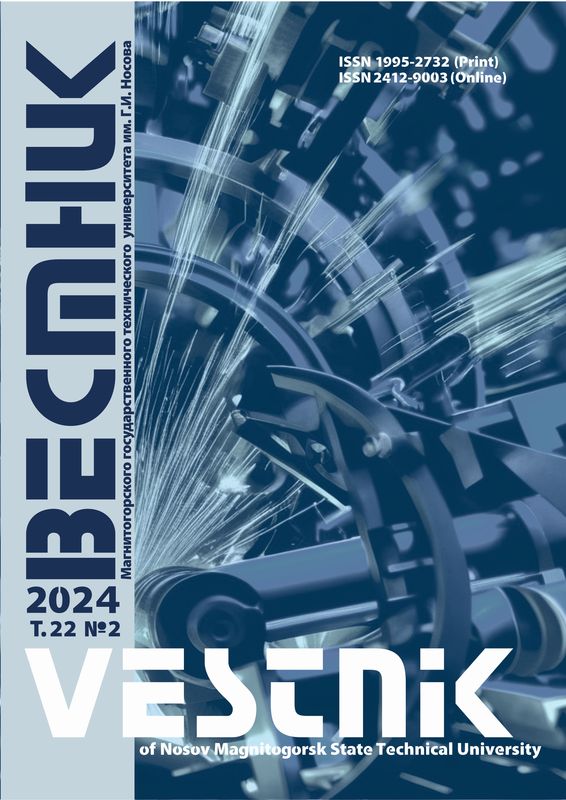DOI: 10.18503/1995-2732-2024-22-2-111-119
Abstract
Problem Statement (Relevance). The frequent change of the product range in the modern world is a relevant issue. Modern CNC machines are developing too rapidly, leaving no opportunity to adjust to the rhythm of machine-building production. Improving the quality of pre-production will help solve this issue. This is possible due to the automation of preparation systems at various levels. To automate systems means to analyze their actions, develop a mathematical model that will bring them as close as possible to the current machining. Modern mathematical models do not take into account many factors, and sometimes the results obtained differ 2-4 times in contrast to the reference data. Hole machining plays an important role in modern manufacturing. The hole is made in several transitions, and the error of the first transition is shifted to the second one, the second one to the third one, etc. Forecasting the error value and reducing the value of this parameter will significantly increase the economic efficiency of production. Objectives. The study is aimed at an experimental investigation of the developed mathematical models for calculating the deflection of the axes of holes, when machining with two flute countersinks with different main cutting edge angles. Methods Applied. A method was developed to conduct experiments using different grades of the material, cutting modes and different sharpening angles of the cutting tool. Originality. It was found that the dissymmetrically sharpened main cutting edge angles of the cutting tool reduced the deflection of the hole axis during machining. Result. It is possible to control accuracy of the location of the axis of the holes, when machining with a dissymmetrically sharpened cutting tool. Practical Relevance. The developed method for calculating the deflection of the hole axis during machining with a dissymmetrically sharpened cutting tool will increase efficiency of designing technological processes for CNC machines.
Keywords
tool sharpening, dissymmetry, hole machining, hole axis deflection, end measuring tools, countersink, monolithic tool, machining error
For citation
Deryabin I.P., Tokarev A.S. An Experimental Study on the Adequacy of a Mathematical Model for Calculating the Deflection of the Axes of Holes when Machining with Two Flute Countersinks. Vestnik Magnitogorskogo Gosudarstvennogo Tekhnicheskogo Universiteta im. G.I. Nosova [Vestnik of Nosov Magnitogorsk State Technical University]. 2024, vol. 22, no. 2, pp. 111-119. https://doi.org/10.18503/1995-2732-2024-22-2-111-119
1. Averchenkov V.I., Vasiliev A.S., Kheifets M.L. Technological heredity in the formation of the quality of manufactured parts. Naukoemkie tekhnologii v mashinostroenii [Science-Intensive Technologies in Mechanical Engineering]. 2018;(10):27-32. (In Russ.)
2. Baranov A.V., Karachev A.V. Determination of technological heredity in machining of holes in gas turbine engine parts. Vestnik mashinostroeniya [Bulletin of Mechanical Engineering]. 2021;(11):37-42. (In Russ.)
3. Gordeeva E.S., Bogutsky V.B., Shron L.B., Novoselov Yu.K. On the issue of factoring into technological heredity in the formation of the properties of parts. Mekhaniki XXI veku [Mechanical Engineers to the 21st century]. 2018;(17):248-254. (In Russ.)
4. Dalsky A.M., Bazarov B.M., Vasiliev A.S. et al. Tekhnologicheskaya nasledstvennost v mashinostroitelnom proizvodstve [Technological heredity in machine-building production]. Moscow: Publishing House of Moscow Aviation Institute, 2000, 364 p. (In Russ.)
5. Deryabin I.P. Metodologiya parametricheskogo proektirovaniya mnogoperekhodnoy obrabotki kruglykh otverstiy kontsevymi mernymi instrumentami: avtoref. dis. … d-ra tekhn. nauk [Methodology of parametric design of multi-pass machining of round holes with end measuring tools. Extended abstract of the doctoral]. Chelyabinsk, 2009. (In Russ.)
6. Deryabin I.P., Guzeev V.I., Kozharina O.A. Studies on inheritance of errors in the location of hole axes during multi-pass machining. Tekhnologiya mashinostroeniya [Mechanical Engineering Technology]. 2008;(6):23-25. (In Russ.)
7. Deryabin I.P., Kozlov A.V. Issledovanie protsessov formoobrazovaniya otverstiy mernymi instrumentami: monografiya [Investigation of the processes of forming holes with measuring instruments: monograph]. Chelyabinsk: South Ural State University, 2006. (In Russ.)
8. Emelyanov S.G., Zubkova O.S., Merzhoeva M.S. Efficiency of using prefabricated countersinks with replaceable polyhedral plates. Vestnik mashinostroeniya [Bulletin of Mechanical Engineering]. 2003;(12):60-61. (In Russ.)
9. Zaitsev A.V., Kolupaev N.A. Methodology for calculating tool axis deviations during machining of small diameter holes. Glavnyi mekhanik [Chief Mechanical Engineer]. 2020;(11):24-30. (In Russ.)
10. Rastorguev G.A. Features of technological inheritance in machine-building production. Spravochnik. Inzhenernyi zhurnal [Handbook. Engineering Journal]. 2013;(9(198)):8-17. (In Russ.)
11. Tokarev A.S., Deryabin I.P., Lopatin B.A. Experimental determination of the hole axis deflection, when machining with countersinks with indexable disposable inserts. Vestnik YuUrGU. Seriya «Mashinostroenie» [Bulletin of SUSU. Series: Mechanical Engineering]. 2020;20(1):55-62. (In Russ.)












